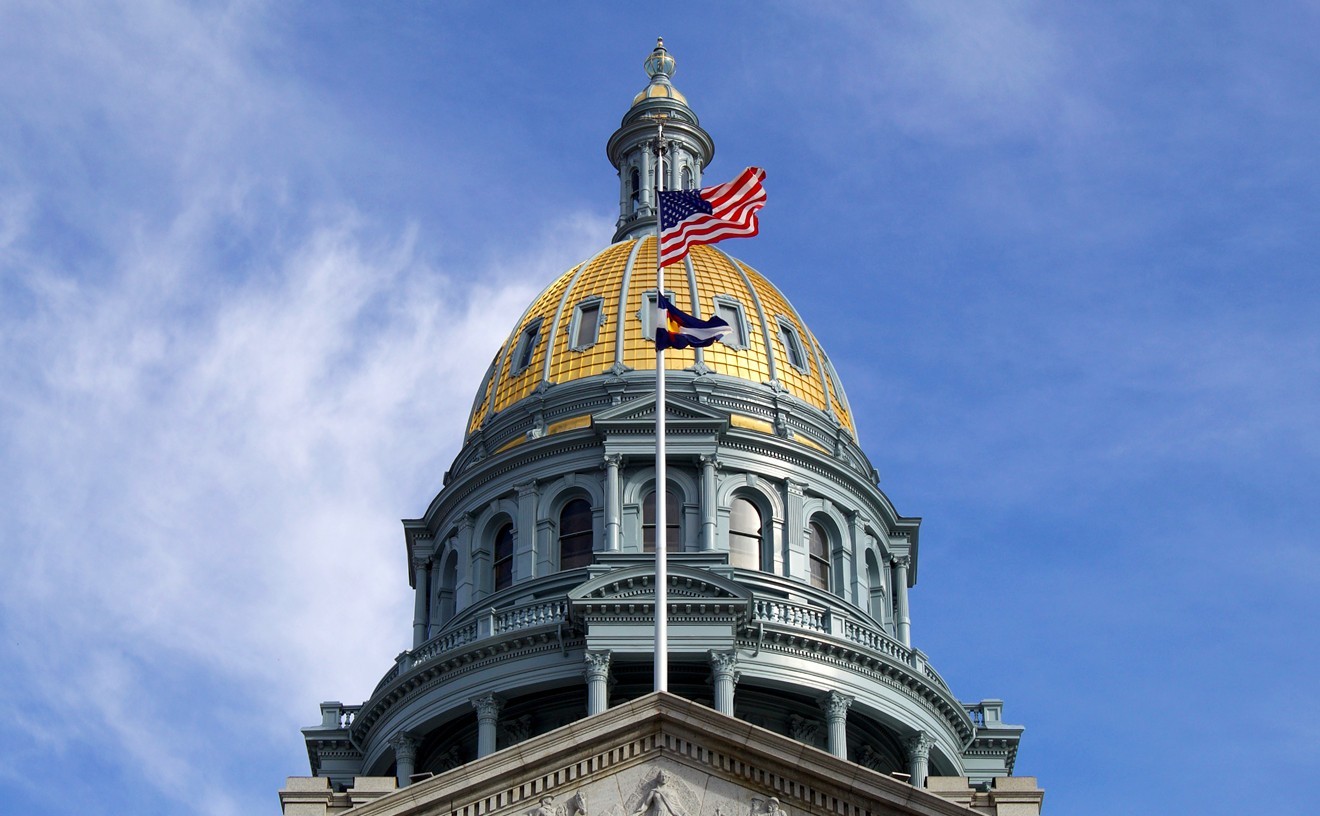The documents had been sought by CBS News for a one-hour documentary on Columbine that aired April 17 on 60 Minutes II ("Lights, Camera...No Comment," April 12). The most damning revelations to emerge from the paper chase were contained in a two-page draft of an affidavit for a search warrant for the house of Columbine gunman Eric Harris, prepared by JCSO investigator Mike Guerra almost a year before the shootings at the high school.
Although never submitted to a judge, Guerra's affidavit demonstrated that the police had more information about Harris and his bomb-making activities than they had previously admitted, yet had failed to pursue the investigation.
Stirred to action by the media furor over the affidavit, the sheriff's office actually issued a press release -- its first detailed comment on a Columbine-related matter since victims' families filed nine lawsuits against Sheriff John Stone a year ago. The release was a momentous event, not unlike a puff of smoke emerging from the Vatican to announce the selection of a new pope.
The press release itself quickly became a matter of controversy. It began by asserting that Judge Brooke Jackson, the judge overseeing the open-records litigation, "was provided access to all of our documentation relative to Columbine" (in court last month, Jackson announced that even he hadn't seen everything the sheriff's office had). It went on to explain that the JCSO had opposed the release of certain materials "to prevent further heartache for the victims' families" -- while neglecting to mention that the families were suing the JCSO for access to those materials.
But the statement that sent reporters scurrying to their clip files was the claim that the search-warrant affidavit was really old news. "A few days after the Columbine shootings, the Sheriff's Office disclosed the existence of the so-called 'secret' search warrant affidavit," the release claimed.
No reporter could find any mention of the affidavit in news coverage after the Columbine shootings. A Westword review of a videotape of the JCSO news conference on April 30, 1999, in which the affidavit was supposedly "disclosed," turned up something else entirely: a running stream of excuses, half-truths and outright lies about what the JCSO knew and did about Eric Harris before he and Dylan Klebold killed thirteen people.
Over the past two years, The House That Stone Walled had plenty of opportunities to tell the truth about its investigation of Harris, but it chose not to -- not until a judge made the JCSO produce the affidavit. For the record, here's what sheriff's department did:
January 30, 1998: Eric Harris and Dylan Klebold are arrested in Deer Creek Canyon for breaking into a van and stealing electrical equipment.
February 15, 1998: A resident of south Jeffco reports a pipe bomb found in a field a few blocks from Harris's house. The size and materials are similar to those of bombs Harris describes in writings posted on his America Online Web pages.
March 18, 1998: Randy Brown reports that Eric Harris is making death threats on his Web site -- including a specific threat against Randy's son, Brooks Brown -- and boasting that he is detonating pipe bombs and vandalizing neighbors' property. He provides a JCSO deputy with ten pages of Harris's writings, downloaded from the Web site. The complaint is written up as a "suspicious incident" rather than as a felony investigation, with Harris listed as a "subject" rather than as a suspect. The report is designated to be forwarded to Neil Gardner, the deputy assigned to work at Columbine High School. Gardner will later claim that he never saw the contents of the report.
March 25, 1998: Harris and Klebold are placed in a juvenile diversion program for the van break-in.
March 31, 1998: After persistent phone calls, Randy and Judy Brown finally obtain a meeting with sheriff's investigator John Hicks concerning Harris's threats. According to the Browns, Hicks is already aware of Harris's previous arrest and record.
April 2, 1998: A criminal background check by JCSO fails to turn up any information on Harris because of his juvenile status and the low-level nature of his felony arrest.
April 11, 1998: Judy Brown contacts the JCSO about an e-mail threat received on her son's computer but then accidentally deleted. A deputy takes the report by phone as a "suspicious incident" and indicates that it should be forwarded to Investigator Hicks.
July 19, 1998: Randy Brown reports that a paintball gun was fired at his garage and that he suspects Eric Harris. The officer writing up the report notes, "No suspects -- no leads."
February 3, 1999: Harris and Klebold are released from the diversion program with glowing reports.
April 20, 1999: Harris and Klebold kill thirteen people, wound two dozen more, and try to blow up Columbine High School before killing themselves.
April 30, 1999: Facing mounting questions about its handling of the Brown complaint, the JCSO issues a press release stating that its investigators couldn't find the Harris Web site and couldn't establish the "elements of a crime" -- in part because the Browns had requested anonymity. But the case had remained officially "open," and Deputy Gardner had kept an eye on Harris and Klebold, the statement says, occasionally engaging them in "light conversation."
At a press conference, Lieutenant John Kiekbusch admits that someone should have called the Browns back to check the Web address, but argues that the case was hardly a promising one. "If you look at the information that was provided to us, some of it is quite outlandish," he tells reporters. "When an individual on a Web site talks about having exploded numerous bombs and kills numerous people -- obviously, that's not happening. So we're looking at it as someone's fantasy, but we're still pursuing it to see if there's any substance here...We compared that information against explosive pipe bomb devices that had been recovered in the county, and there was nothing to match up there."
But Harris didn't write that he had killed numerous people; he wrote that he was going to kill people. And the Browns vigorously dispute the JCSO's contention that they did not want the case followed up or Harris's parents contacted.
May 4, 1999: Appearing on the Today show, Sheriff Stone suggests the Browns' criticism is "a smokescreen to divert attention" from their son's friendship with Klebold and Harris. "Brooks Brown could possibly be a suspect," he says.
Summer 1999-Spring 2000: The Browns make numerous requests for the complete case file on their complaint. They are given essentially the same paperwork each time, but nothing that indicates any followup by the JCSO or even any written record of their meeting with John Hicks. JCSO officials repeatedly tell reporters that the Browns never met with Hicks -- a claim they will continue to make right up until the affidavit surfaces.
May 15, 2000: Judge Jackson orders the release of the JCSO's much-delayed final report on Columbine. The report notes that, after the shootings, Jefferson County District Attorney Dave Thomas was provided with information from the Harris writings and assured the investigators that "there would have been insufficient basis to legally support a request to obtain search or arrest warrants." The report fails to mention, though, whether anyone at JCSO had ever drafted or even contemplated a search warrant affidavit.
November 21, 2000: Judge Jackson orders the release of 11,000 pages of police investigative files on Columbine. The Brown case file is included, but nothing that suggests the case was ever pursued. However, other documents show that investigators had no difficulty accessing Harris's Web site immediately after the shootings. They also show that the Brown complaint was listed as "closed" before April 20, 1999 -- and long before the JCSO insisted it was still an open lead.
February 20, 2001: In response to a request from CBS News seeking any additional paperwork connected to the Brown complaint not previously released, Jeffco assistant county attorney William Tuthill denies that such paperwork exists. "A copy of the 1998 Brown complaint was placed in the investigative files for reference," he notes.
March 19, 2001: Having confirmed the existence of Guerra's affidavit with District Attorney Thomas, CBS asks Judge Jackson to order it to be released.
April 10, 2001: In compliance with Jackson's order, the affidavit is finally released, two years after the shootings and nearly three years after it was written. It establishes that Hicks not only met with the Browns, but passed on the Web pages to Guerra. Contrary to Kiekbusch's assertion that the investigators were unable to "match up" the bomb information with any existing cases, Guerra suspected a link between the bombs described in Harris's writings and the one found in a field on February 15, 1998. The document also lists a correct street address -- and a possible Web address -- for Eric Harris.
April 12, 2001: In a newly released interview with an Arvada investigator, conducted hours after the Columbine shooting, Deputy Neil Gardner states he "had never dealt with Eric Harris" before the gunfight that day and didn't recognize a photo of him -- raising fresh questions about how he could ever have engaged in conversation, light or otherwise, with someone he had never met.
For more Westword coverage of the Columbine Shootings, go to our Columbine Reader











